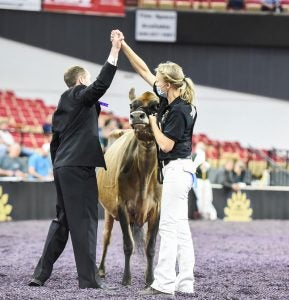Hundreds of college students and 4-H’ers packed up and headed to America’s Dairyland in September to show off their dairy judging skills during competitions at the World Dairy Expo.
At the intercollegiate level, Cornell University ranked as the top team in 2021, followed by Virginia Tech and Iowa State University. Two Cornell team members, Bryce Windecker and Johnathan King, won first and second place as individuals, respectively.
Some people inside and outside of agriculture may ask, how do you judge a dairy cow? In short, we’re generally talking about things like their udders and rump — and even the animal’s “dairyness.” After all, many see this as a very serious sport!
But I wanted to dive deeper and to take some of these questions right to the experts. Along with Windecker and King, Cornell team members Grace Harrigan and Laura Littrell got into all the nitty-gritty details of how dairy cattle are judged.

To start off, there is a PDCA scorecard that is used as reference. This scorecard lays out what qualities are desirable in cattle, and how much weight to give to each quality. The four main areas of interest are the udder, dairy strength, rear feet and legs, and frame. The scorecard also lays out specific breed characteristics of the seven recognized dairy cattle breeds.
When it comes to the perfect udder, Laura Littrell explains, “We first look for it to be attached high, and sit above the hock. Udders low to the ground are susceptible to bacteria. We want them high and wide, and uniform in width from the base of the udder to the top of the attachment. We want a strong rear attachment, and a defined cleft; the stronger the attachment the longer the udder will hold up. We want squarely placed teats, not too far together or too close. Also don’t want teats too big, that would increase the risk of them getting stepped on. We also look for a long shallow fore udder that blends smoothly.”
Grace Harrigan explains that feet and legs are a very important piece to judging. She says that cows need to be able to move around comfortably in order to live a long, comfortable life. “Previously we concentrated on set or straightness to hock, but now we focus more on functionality, moving away from straightness,” she says. “We want cows to have freedom of movement, to track well while walking around the barn. We look for legs that will increase animal longevity and health.”

When it comes to the frame, Bryce Windecker says, “There are many components to the proper function of a cow’s frame. A cow should have a wide muzzle, conducive for eating a lot of feed to produce milk. Next, she should have a wide, open deep chest for strength and stability; allowing for a deep, open, sweeping rib structure for consuming many nutrients. Her back (topline) needs to be straight and smooth for longevity. The width should carry her back to a wide, slightly sloped rump. This width enables the cow to have an easy calving and have a clean rear end.”
Dairy strength sounds a little ambiguous, but Johnathan King clarifies that “dairy farmers prefer stronger cows in the show ring and in their barns so that they are able to live longer and have a lower risk of injuring themselves. When it comes to dairy strength we look for a wide stance in the front end that also shows depth, and we want them to carry their width throughout their rib and rump structures as well as their hind legs. Today, dairy strength is considered to be one of the more important areas that dairy farmers and enthusiasts look for in dairy cattle.”
As explained by the national experts, judging dairy cattle is not about picking the cutest cow. The perfect cow is a cow that will have a long and productive life in the milking herd.
Elizabeth Maslyn is a Cornell University student pursuing a career in the dairy industry. Her passion for agriculture has driven her desire to learn more, and let the voices of our farmers be heard.



